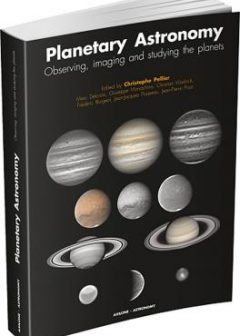Planetary Astronomy
| By Christophe Pellier (Ed.) | Reviewed by Martin Lewis |
| Axilone 2020 | 288 pages |
| Price £50.95 | ISBN:979-10-92974- 05-8 |

Planetary Astronomy is a comprehensive reference book on observing and imaging the planets in our solar system. Written by seven highly experienced French and Belgian amateurs (Christian Viladrich, Marc Delcroix, Jean-acques Poupeau, Frédéric Burgeot, Giuseppe Monachino and Jean-Pierre Prost) and edited by hugely respected planetary imager Christophe Pellier, the book has been translated from French by Pellier and Viladrich, together with Stefan Hughes. The translation has been skilfully done, with no awkwardness in the prose or oddities of language – indeed, it is hard to believe it was not written in English from the start.
Although some of the information presented is available online and from some advanced amateur imagers via Patreon-type sign-up, this book adds much more and pulls the information on the subject together into one accessible, coherent and well-balanced volume. Although a small number of books have been previously written on planetary photography using high-speed video cameras with ‘lucky imaging’, none have been written for a while and none go into the depth that this work does. Planetary Astronomy comprises almost 300 lavishly illustrated A4-sized pages and I found it a joy to read and skim through.
The book is split into two halves. The first gives information on telescopes, cameras and how to both image and draw the planets – the methods, techniques and pitfalls for the amateur astronomer. There is some theory in there, but generally the book is written from a strongly practical stance and many points are illustrated with figures created just for the book. The subject area is large and complex and obviously, the exact observing and imaging techniques described are sometimes a matter of personal preference and opinion. However, overall the book gives a pretty good picture of the current state of play for advanced planetary imaging techniques. The chapter on telescopes is particularly informative. It gives interesting perspectives on the relative benefits of different telescope designs for planetary imaging and observation – presenting in-depth information that you would be hard pressed to find anywhere else.
The second half of the book concentrates on individual planets, giving information on the appearance of each in turn and detailing the challenges presented in imaging and observing that particular body. Recommendations on various techniques, such as the use of different filters, are made for each planet together with features to look out for. Again, chapters are extremely comprehensive and well illustrated.
Planetary Astronomy is a practical book for the intermediate or advanced amateur who wishes to extend their knowledge, learn about new challenges and develop new techniques. One of its few omissions, however, is the lack of a comprehensive index. There is a contents list, but that is much less useful and this does hamper it somewhat as a reference volume.
If you regularly image or observe the planets, this book comes highly recommended
Martin Lewis has been regularly imaging the planets since 2007. His main imaging telescope is a 444mm Dobsonian which he uses from his St Albans garden. He is a regular contributor to the BAA Sections and was a prize-winner in the 2018/2019/2020 Astronomy Photographer of the Year competitions
| The British Astronomical Association supports amateur astronomers around the UK and the rest of the world. Find out more about the BAA or join us. |
